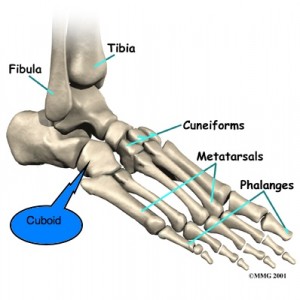Cuboid is a bone located at the outer aspect of the foot, which connects the 4th and 5th metatarsals to the heel bone or calcaneus. This can be seen in the diagram below. Though the chances of fractures occurring to the cuboid are quite low and rare to see in clinical practice, it can still occur and sometimes be missed.
Figure 1www.medicalpicturesinfo.com
Like for all fractures, the two main causes for a fracture to occur at the cuboid include:
- Trauma
- Stress
Some of the causes for a traumatic or stress fracture to occur include:
- Motor-vehicle accidents
- Athletic injuries
- Misstep of a height
It can be seen that through most of these causes, the common action that is performed to cause a fracture at the cuboid is similar to the ‘nut-cracker’ – where the foot plantar flexes (moves downwards), abducts (outwards), causing the cuboid bone to be crushed between the calcaneus and the metatarsals. This can be visually seen using the image above. This may then alter the length of the outer arch, also known as the lateral longitudinal arch, which can then change the position of the foot when weight bearing and cause long-term instability or pain.
Stress fracture at the cuboid usually occurs due to athletic injuries and commonly affects the inner aspect of the bone. The bone usually fatigues and can form a small crack.
Symptoms
Some common symptoms include:
-
- Pain or instability when weight bearing
- Localised bruising or tenderness
- Pain increases with increase in activity levels
- Pain may radiate to the heel, sole or toes of the foot
- Presence of pain at night
- Pain when firmly holding the outer aspect of the foot
Contributing factors
- Poor foot posture
- Muscle weakness
- Reduced flexibility
- Inappropriate footwear
- Poor running technique
- Excessive or inappropriate exercise
Treatment
Treatment does depend on the type of stress fracture that is present. This is usually determined based on physical examination and/or radiographic imaging, including X-rays.
For further information and discussion on the treatment and management, please do visit your friendly podiatrist.
Reference
http://coordinatedhealth.com/condition/cuboid-fracture/
http://www.ncbi.nlm.nih.gov/pmc/articles/PMC3687911/
http://www.physioadvisor.com.au/14779150/cuboid-stress-fracture-physioadvisor.htm


Comments are closed.